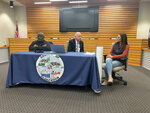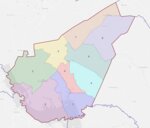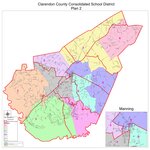



On Thursday, Dec. 13, the Manning and Clarendon County chapters of the National Association of the Advancement of Colored People (NAACP) hosted a meeting regarding the proposed district lines for the election of the Clarendon County School District Board of Trustees.
The Clarendon County School Board has been an appointed board for about forty years and after public input, is moving to an elected board with the intention of candidates being featured on the 2024 county ballots. In order to have the School Board candidates on the upcoming ballot, the map of the nine districts must be agreed upon by both House Representative Fawn Pedalino and State Senator Kevin L. Johnson.
The meeting began with a call to order from Julius Adger, President of the Clarendon Branch of the
NAACP. After the invocation and Pledge of Allegiance, Moses Levy, Jr., from the Manning Branch of the
NAACP, explained the purpose of the meeting. “We want to tell you from the very beginning that this meeting is centered on one focal point and that is how the Clarendon County district lines will be drawn for the election of our county board of trustees.” Levy also emphasized that “the school system [itself] and how it’s being run” would not be addressed at the meeting, foreshadowing how the gathering would devolve later in the evening.
Representative Pedalino was the first to present their proposed map. Pedalino stated that the bill introduced by Senator Johnson was incomplete and her team was working on the district map presently.
“I got with the gentlemen who actually came up with Clarendon County maps that we were [going to] use for the referendum and he came up with a map for me.” Pedalino continued that her proposal had nine single member districts, drawn in accordance with where the members of the current, appointed board are now residing. She further explained that her proposed map and Johnson’s proposed map were very similar, and both met the same, mandated criteria.
Senator Johnson then presented his map to the meeting attendees. Johnson began his presentation by emphasizing that “passing this bill and drawing these lines is (sic) important because once we draw the lines, that’s not the end of the equation. The Voter Registration Office still has a lot of work to do to prepare for an election.” Johnson used different cartographers than Pedalino, his being the firm that draws maps for the state elections. The map Johnson is proposing also has nine single member districts, with four districts comprised of mainly Republican and/or white voters, four districts comprised of mainly Democrat and/or black voters, and a “toss-up” district where the vote is split almost 50-50 between the two main voting blocks.
The contention between the two maps seems to be the toss-up district and whether to include the prison population in Turbeville. Johnson stated that his toss-up district is “as close to fifty-fifty as you want it to be” while Pedalino’s toss-up district is 46-54. Pedalino’s map also includes the population of the Turbeville Correctional Institution. As inmates cannot vote and most are not from Clarendon County, Johnson believes including these inmates “skews the lines and distorts the numbers.” He also argued that while inmate populations have been included in state elections, it is common practice to exclude these numbers from local elections because of the different outcomes those numbers can determine.
After the Representative and the Senator presented their map proposals, remarks were made to the elected officials on behalf of the SC State Branches of the NAACP by their consultant, John C. Ruoff,
Ph.D. Ruoff has been advising in local redistricting issues since the early 90s and has appeared many times as an expert witness in federal court cases regarding voting rights and redistricting. Ruoff’s presence was clearly requested by the NAACP, but after listing his credentials for the attendees, Ruoff let out a small, exasperated sigh before addressing our public officials. Ruoff then spoke for most constituents in Clarendon County when he began his remarks with, “I think one thing you should be clear about is part of the reason [for this meeting] is we think you should work it out.”
Ruoff continued, explaining that filing a lawsuit over the two maps should be a last resort, not a first choice. The cost of a lawsuit would be exponential and so would the amount of time it would take for a verdict. Time is a huge factor with the school board election map, as the Voter Registration Office (VRO) needs time to send out new cards to voters before the election. In fact, Ruoff expounds, the VRO would have preferred to have had the map ratified last July.
Lastly, Ruoff clarified that while the prison population inclusion is, in the end, up to the jurisdiction, it is not common practice to include those numbers in local redistricting. Echoing Senator Johnson’s earlier speech, Ruoff offered, “that they are included in state line redistricting because it doesn’t matter in most cases but when you get into small jurisdictions it begins to matter that you have a chunk of folk who are not eligible to vote, who have no real commitment in the community there.”
On paper, the ground plan seems similar, and a compromise could be easily achieved. However, the
Senator and Representative cannot seem to move past the hotly contested House District 64 election in 2022.
If you are a resident in Clarendon County with even a passing interest in local politics, you’re aware that getting the Senator and Representative in a room together rarely ends with a cohesive decision. Both the moderators and the attendees of this meeting seemed to be prepared for a heated debate on a topic that should be fairly easy to agree on.
As the meeting moved on to the question-and-answer segment, the first question was made to the Senator regarding using the verbiage “incumbent” when the board is currently appointed. This question would have likely taken just a few moments for an answer had it not been asked by a gentleman from the Pedalino campaign. As such, the Senator immediately became defensive while explaining that Clarendon County Legislative Delegation appointed the school board and not solely himself nor his daughter, former Representative Kimberly Johnson. As these encounters in the county meetings tend to go, it quickly became a back and forth of past issues that related very little to the topic at hand.
As the bickering continued throughout the Q&A segment, attendees became irritated that Johnson and Pedalino seemed to refuse to work with one another on the school board district map. When asked directly if a third party, whether by independent commission, computer software, or a mediator, drew a combination of their maps, would they be able to agree, their answers were still hazy. The only clarity the guests had was that nothing was going to be accomplished that evening and their frustration grew.
Community leader and Director of K&H Resource Center, Kathleen Gibson, summarized what everyone in the room seemed to be thinking, “No one has said nothing (sic) about the children … the children. The children are watching us. We need to act like Christian adults. I’ve worked with kids for forty plus years … let’s get this together. Let’s think about our children. They’ve lost all those years to [COVID], they did so much. Let’s get together as one for the children and put our feelings out the window.”
Gibson’s remarks fell on deaf ears, however, as within a few minutes, the Senator was again engaging in back and forth with attendees without a resolution in sight. Finally, Adger regained control of the proceeding and called for the closing prayer. Simultaneously, Pedalino, Johnson, and Ruoff could be heard whispering amongst themselves. As heads in the room lifted from their prayer, Johnson tried to reassure the displeased group.
“We’ll meet. We’re going to meet.”